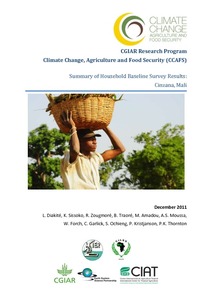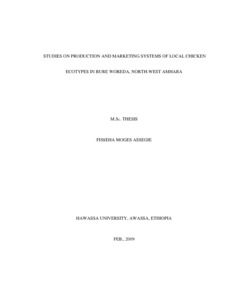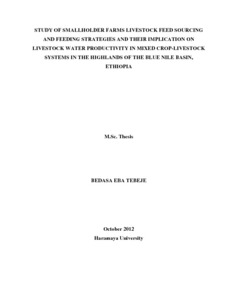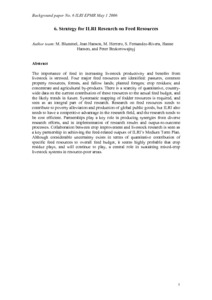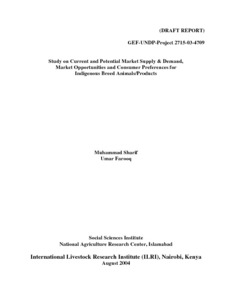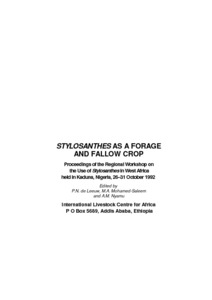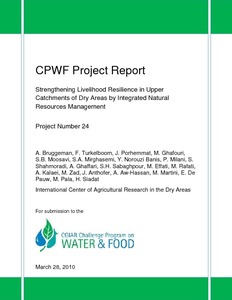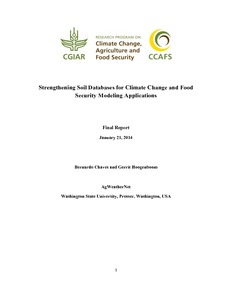Tierras de pastos
AGROVOC URI:
Summary of household baseline survey results: Cinzana, Mali
Studies on production and marketing systems of local chicken ecotypes in Burie Wereda, north west Amhara
Strategies for adapting to climate change in rural Sub-Saharan Africa
Given limited resources, adaptation strategies must target those populations most vulnerable to global change and equip those unable to adapt—generally the poorest—with the tools and incentives that will enable them to do so. ASARECA has recently carried out a study to enhance the understanding of climate change in the 10 ASARECA member countries. This report profiles the available climate change–related datasets and their accessibility and procurement details in the 10 ASARECA member countries.
Study of smallholder farms livestock feed sourcing and feeding strategies and their implication on livestock water productivity in mixed crop-livestock systems in the highlands of the Blue Nile Basin, Ethiopia
This study was conducted to assess livestock feed sourcing and feeding strategies and their implications on livestock water productivity (LWP) in mixed crop-livestock production systems of the Blue Nile Basin (BNB) in Ethiopian Highlands. Three Woredas (Diga, Jeldu and Fogera) representing diverse agricultural farming systems were considered. One watershed in each Woreda, which is Dapo from Diga, Meja from Jeldu and Mizuwa from Fogera were selected. Each watershed further stratified to different farming systems depending on cropping pattern and landscape positions.
Strategy for ILRI research on feed resources
The importance of feed in increasing livestock productivity and benefits from livestock is stressed. Four major feed resources are identified: pastures, common property resources, forests, and fallow lands; planted forages; crop residues; and concentrate and agricultural by-products. There is a scarcity of quantitative, countrywide data on the current contribution of these resources to the actual feed budget, and the likely trends in future. Systematic mapping of fodder resources is required, and seen as an integral part of feed research.
Study on current and potential market supply and demand, market opportunities and consumer preferences for indigenous breed animals/products
Stylosanthes as a forage and fallow crop. Proceedings of a regional workshop on the use of Stylosanthes in West Africa
This report is divided into seven sections. The first section deals with biology of Stylosanthes and its importance in West Africa and Latin America. The second section presents papers on the screening and evaluation of Stylosanthes germplasm. This includes genetic diversity, genetic resources, species screening, multi-locational testing and evaluation of accessions. The third part discusses the dynamics, nutrient requirements, and pests and diseases of Stylosanthes species. Section four looks at Stylosanthes-based pastures for livestock production.
Strengthening livelihood resilience in upper catchments of dry areas by integrated natural resources management
The Livelihood Resilience project evolved around the hypothesis that better integrated
management can improve the livelihoods of poor farming communities and increase the
environmental integrity and water productivity of upstream watersheds in dry areas. This
hypothesis was tested by researchers from different Iranian research and executive organizations
and farming communities in two benchmark research watersheds in upper Karkheh River Basin in
Iran, under the guidance of the ICARDA scientists. Participatory technology development, water,
Summary of baseline household survey results: Borana, Ethiopia
Strengthening Soil Databases for Climate Change and Food Security Modeling Applications
Climate change is a hazard to the food security of a growing world population since it affects agriculture and likewise, agriculture and natural resource management affect the climate system. The relationships between all these factors including polices, political conditions, economical management and pest and diseases, and how they interact are not currently well-understood, nor are the advantages and disadvantages of different responses to climate change.


